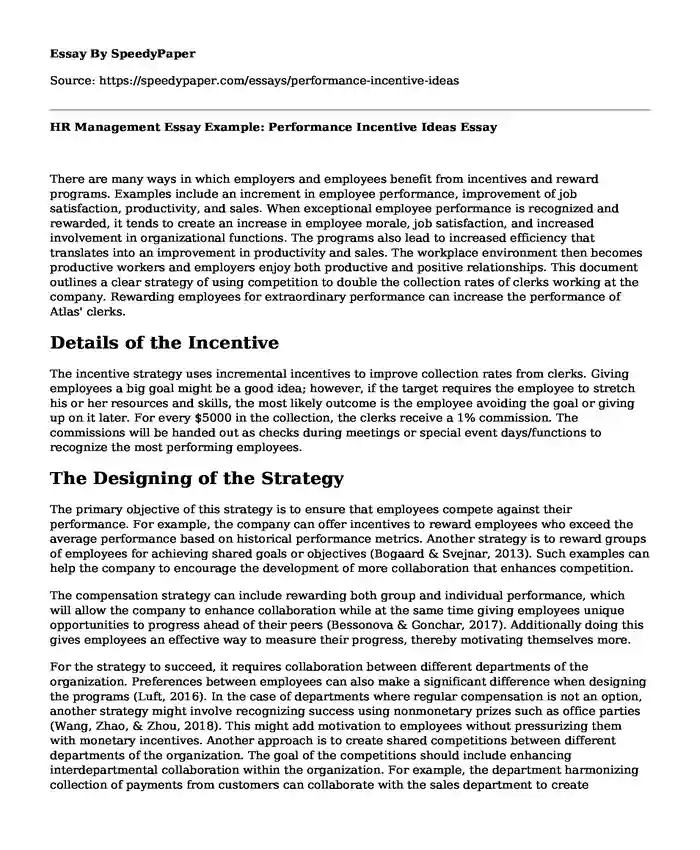
| Type of paper: | Essay |
| Categories: | Management Human resources |
| Pages: | 3 |
| Wordcount: | 719 words |
There are many ways in which employers and employees benefit from incentives and reward programs. Examples include an increment in employee performance, improvement of job satisfaction, productivity, and sales. When exceptional employee performance is recognized and rewarded, it tends to create an increase in employee morale, job satisfaction, and increased involvement in organizational functions. The programs also lead to increased efficiency that translates into an improvement in productivity and sales. The workplace environment then becomes productive workers and employers enjoy both productive and positive relationships. This document outlines a clear strategy of using competition to double the collection rates of clerks working at the company. Rewarding employees for extraordinary performance can increase the performance of Atlas' clerks.
Details of the Incentive
The incentive strategy uses incremental incentives to improve collection rates from clerks. Giving employees a big goal might be a good idea; however, if the target requires the employee to stretch his or her resources and skills, the most likely outcome is the employee avoiding the goal or giving up on it later. For every $5000 in the collection, the clerks receive a 1% commission. The commissions will be handed out as checks during meetings or special event days/functions to recognize the most performing employees.
The Designing of the Strategy
The primary objective of this strategy is to ensure that employees compete against their performance. For example, the company can offer incentives to reward employees who exceed the average performance based on historical performance metrics. Another strategy is to reward groups of employees for achieving shared goals or objectives (Bogaard & Svejnar, 2013). Such examples can help the company to encourage the development of more collaboration that enhances competition.
The compensation strategy can include rewarding both group and individual performance, which will allow the company to enhance collaboration while at the same time giving employees unique opportunities to progress ahead of their peers (Bessonova & Gonchar, 2017). Additionally doing this gives employees an effective way to measure their progress, thereby motivating themselves more.
For the strategy to succeed, it requires collaboration between different departments of the organization. Preferences between employees can also make a significant difference when designing the programs (Luft, 2016). In the case of departments where regular compensation is not an option, another strategy might involve recognizing success using nonmonetary prizes such as office parties (Wang, Zhao, & Zhou, 2018). This might add motivation to employees without pressurizing them with monetary incentives. Another approach is to create shared competitions between different departments of the organization. The goal of the competitions should include enhancing interdepartmental collaboration within the organization. For example, the department harmonizing collection of payments from customers can collaborate with the sales department to create harmonized competitions.
Measuring the Effectiveness of the Program
There are different ways to track the progress of the launching of the program. One way to track progress is through the use of data against a predetermined benchmark (Bogaard & Svejnar, 2013). For example, if the goal of the competition is to increase collection rates of clerks, information from the competition in the sales department can be correlated with information from another department, such as purchasing, to identify interesting patterns. Interdepartmental competitions all corporations can also help employees to think outside the box and understand how departments influence each other with the organization.
Conclusion
Rewarding employee performance is key to improving their morale and productivity. Atlas can accomplish this is by creating a competitive culture that rewards the best employee performance. Atlas can implement the proposed strategy through interdepartmental collaboration where departments run competition programs based on organizational objectives where employees are given monetary and non-monetary rewards after achieving individual or group targets. Departments within the organizations are also encouraged to share information from competition and reward programs aimed at improving the user experience.
References
Bessonova, E., & Gonchar, K. (2017). Incentives to innovate in response to the competition: The role of agency costs. Economic Systems, 41(1), 26-40.
Bogaard, H., & Svejnar, J. (2013). Incentive Pay and Performance: Insider Econometrics in a Multi-Unit Firm. SSRN Electronic Journal, 54(8), 110-115.
Luft, J. (2016). Cooperation and competition among employees: Experimental evidence on the role of management control systems. Management Accounting Research, 31(8), 75-85.
Wang, L., Zhao, J. Z., & Zhou, K. Z. (2018). How do incentives motivate absorptive capacity development? The mediating role of employee learning and relational contingencies. Journal of Business Research, 85(6), 226-237.
Cite this page
HR Management Essay Example: Performance Incentive Ideas. (2022, Sep 19). Retrieved from https://speedypaper.com/essays/performance-incentive-ideas
Request Removal
If you are the original author of this essay and no longer wish to have it published on the SpeedyPaper website, please click below to request its removal:
- Free Essay on Individual Style of Writing
- Marketing Essay Example: Abano Dental Clinic
- Free Essay on the Schizophrenia Case: Diagnosis and Treatment
- Vision and Opportunity - The Personal Business Plan Example
- Free Essay on the Telecommunications and Media Company: Telstra's Global Strategy
- HR Management Essay Example: Performance Incentive Ideas
- Essay Example - Hazardous Waste Operations and Emergency Response
Popular categories




